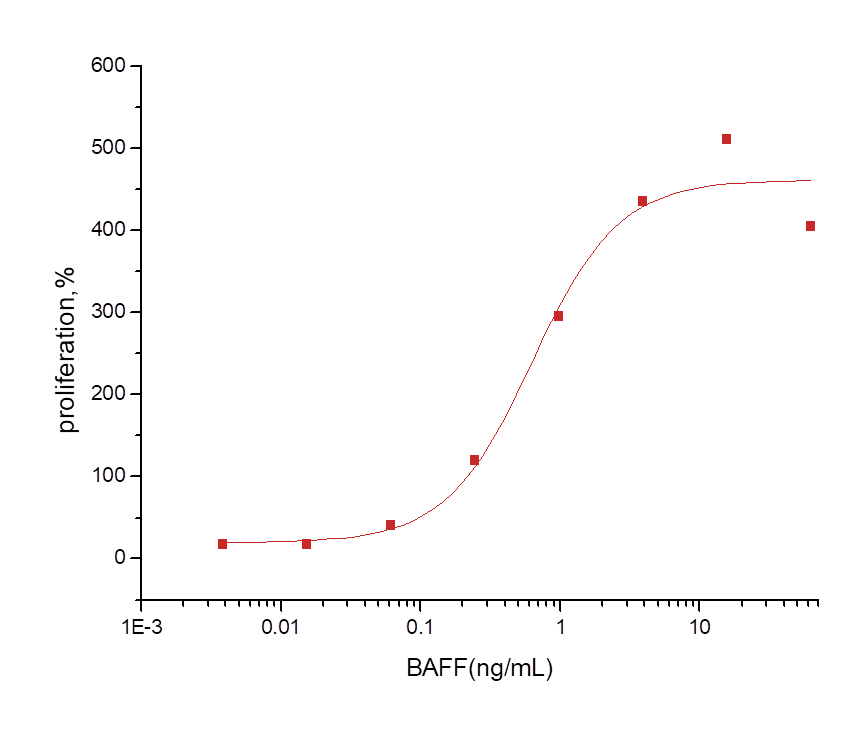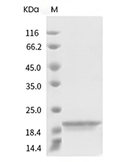Shopping Cart
- Remove All
 Your shopping cart is currently empty
Your shopping cart is currently empty

BAFF/TNFSF13B Protein, Human, Recombinant (HEK293) is expressed in HEK293 mammalian cells. The predicted molecular weight is 17 kDa and the accession number is Q9Y275-1.

| Pack Size | Price | Availability | Quantity |
|---|---|---|---|
| 100 μg | $447 | In Stock | |
| 200 μg | $763 | 7-10 days | |
| 500 μg | $1,540 | 7-10 days |
| Biological Activity | Measured in a cell proliferation assay using mouse splenocytes. The ED50 for this effect is typically 0.4-2 ng/mL.  |
| Description | BAFF/TNFSF13B Protein, Human, Recombinant (HEK293) is expressed in HEK293 mammalian cells. The predicted molecular weight is 17 kDa and the accession number is Q9Y275-1. |
| Species | Human |
| Expression System | HEK293 Cells |
| Tag | Tag Free |
| Accession Number | Q9Y275-1 |
| Synonyms | ZTNF4,tumor necrosis factor (ligand) superfamily, member 13b,TNFSF20,THANK,TALL-1,TALL1,DTL,CD257,BLYS,BAFF |
| Construction | A DNA sequence encoding the soluble form of human BAFF (Q9Y275-1) (Ala 134-Leu 285) was expressed and purified. Predicted N terminal: Ala 134 |
| Protein Purity | > 95 % as determined by SDS-PAGE  |
| Molecular Weight | 17 kDa (predicted); 19 kDa (reducing conditions) |
| Endotoxin | < 1.0 EU/μg of the protein as determined by the LAL method. |
| Formulation | Lyophilized from a solution filtered through a 0.22 μm filter, containing PBS, pH 7.4. Typically, a mixture containing 5% to 8% trehalose, mannitol, and 0.01% Tween 80 is incorporated as a protective agent before lyophilization. |
| Reconstitution | A Certificate of Analysis (CoA) containing reconstitution instructions is included with the products. Please refer to the CoA for detailed information. |
| Stability & Storage | It is recommended to store recombinant proteins at -20°C to -80°C for future use. Lyophilized powders can be stably stored for over 12 months, while liquid products can be stored for 6-12 months at -80°C. For reconstituted protein solutions, the solution can be stored at -20°C to -80°C for at least 3 months. Please avoid multiple freeze-thaw cycles and store products in aliquots. |
| Shipping | In general, Lyophilized powders are shipping with blue ice. |
| Research Background | B lymphocyte stimulator (BLyS), also known as TNFSF13B, CD257 and BAFF, is a single-pass type II membrane protein, which belongs to the tumor necrosis factor family. BAFF is abundantly expressed in peripheral blood Leukocytes and is specifically expressed in monocytes and macrophages. BAFF is a cytokine and serves as a ligand for receptors TNFRSF13B (TACI), TNFRSF17 (BCMA), and TNFRSF13C (BAFFR). These receptors are a prominent factor in B cell differentiation, homeostasis, and selection. BLyS levels affect survival signals and selective apoptosis of autoantibody-producing B cells. Thus, it acts as a potent B cell activator and has been shown to play an important role in the proliferation and differentiation of B cells. Overexpression of BLyS in mice can lead to clinical and serological features of systemic lupus erythematosus (SLE) and Sjögren's syndrome (SS). BLyS is an attractive therapeutic target in human rheumatic diseases. The ability of BLyS to regulate both the size and repertoire of the peripheral B cell compartment raises the possibility that BLyS and antagonists thereof may form the basis of a therapeutic trichotomy. As an agonist, BLyS protein may enhance humoral immunity in congenital or acquired immunodeficiencies such as those resulting from viral infection or cancer therapy.Cancer ImmunotherapyImmune CheckpointImmunotherapyTargeted Therapy |

Copyright © 2015-2025 TargetMol Chemicals Inc. All Rights Reserved.